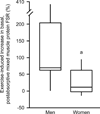Muscle protein synthesis response to exercise training in obese, older men and women
- PMID: 22246218
- PMCID: PMC3354005
- DOI: 10.1249/MSS.0b013e3182496a41
Muscle protein synthesis response to exercise training in obese, older men and women
Abstract
Introduction: Physical activity and eating are two major physiological muscle growth stimuli. Although muscle protein turnover rates are not different in young and middle-aged men and women, we recently found that the basal rate of muscle protein synthesis is greater and the anabolic response to mixed-meal intake is blunted in 65- to 80-yr-old women compared with men of the same age. Whether older women are also resistant to the anabolic effect of exercise is not known.
Methods: We measured the rate of muscle protein synthesis (both during basal, postabsorptive conditions and during mixed-meal intake) before and after 3 months of exercise training in obese, 65- to 80-yr-old men and women.
Results: At the beginning of the study (before training) the basal, postabsorptive muscle protein fractional synthesis rate (FSR) was significantly greater in women than in men (0.064 ± 0.006%·h(-1) vs 0.039 ± 0.006%·h(-1), respectively, P < 0.01), whereas the meal-induced increase in the muscle protein FSR was greater in men than in women (P < 0.05). In men, exercise training approximately doubled the basal muscle protein FSR (P = 0.001) but had no effect on the meal-induced increase in muscle protein FSR (P = 0.78). In women, exercise training increased the muscle protein FSR by ~40% (P = 0.03) and also had no effect on the meal-induced increase in muscle protein FSR (P = 0.51).
Conclusions: These results suggest that there is significant sexual dimorphism not only in the basal, postabsorptive rate of muscle protein synthesis but also in the anabolic response to feeding and exercise training in obese, older adults.
Conflict of interest statement
Figures


Similar articles
-
Effect of weight loss on the rate of muscle protein synthesis during fasted and fed conditions in obese older adults.Obesity (Silver Spring). 2012 Sep;20(9):1780-6. doi: 10.1038/oby.2011.280. Epub 2011 Sep 22. Obesity (Silver Spring). 2012. PMID: 21938075 Free PMC article.
-
Regular multicomponent exercise increases physical fitness and muscle protein anabolism in frail, obese, older adults.Obesity (Silver Spring). 2011 Feb;19(2):312-8. doi: 10.1038/oby.2010.110. Epub 2010 May 20. Obesity (Silver Spring). 2011. PMID: 20489691 Free PMC article.
-
No major sex differences in muscle protein synthesis rates in the postabsorptive state and during hyperinsulinemia-hyperaminoacidemia in middle-aged adults.J Appl Physiol (1985). 2009 Oct;107(4):1308-15. doi: 10.1152/japplphysiol.00348.2009. Epub 2009 Jul 30. J Appl Physiol (1985). 2009. PMID: 19644030 Free PMC article. Clinical Trial.
-
Human muscle protein synthesis and breakdown during and after exercise.J Appl Physiol (1985). 2009 Jun;106(6):2026-39. doi: 10.1152/japplphysiol.91481.2008. Epub 2009 Jan 22. J Appl Physiol (1985). 2009. PMID: 19164770 Review.
-
Human muscle protein turnover--why is it so variable?J Appl Physiol (1985). 2011 Feb;110(2):480-91. doi: 10.1152/japplphysiol.00125.2010. Epub 2010 Nov 25. J Appl Physiol (1985). 2011. PMID: 21109595 Free PMC article. Review.
Cited by
-
Effects of Protein Supplementation Combined with Resistance Exercise Training on Walking Speed Recovery in Older Adults with Knee Osteoarthritis and Sarcopenia.Nutrients. 2023 Mar 23;15(7):1552. doi: 10.3390/nu15071552. Nutrients. 2023. PMID: 37049391 Free PMC article.
-
The effects of resistance exercise training on macro- and micro-circulatory responses to feeding and skeletal muscle protein anabolism in older men.J Physiol. 2015 Jun 15;593(12):2721-34. doi: 10.1113/JP270343. Epub 2015 May 14. J Physiol. 2015. PMID: 25867865 Free PMC article. Clinical Trial.
-
Preserved anabolic threshold and capacity as estimated by a novel stable tracer approach suggests no anabolic resistance or increased requirements in weight stable COPD patients.Clin Nutr. 2019 Aug;38(4):1833-1843. doi: 10.1016/j.clnu.2018.07.018. Epub 2018 Jul 31. Clin Nutr. 2019. PMID: 30100106 Free PMC article. Clinical Trial.
-
Improvements in skeletal muscle fiber size with resistance training are age-dependent in older adults: a systematic review and meta-analysis.J Appl Physiol (1985). 2020 Aug 1;129(2):392-403. doi: 10.1152/japplphysiol.00170.2020. Epub 2020 Jul 23. J Appl Physiol (1985). 2020. PMID: 32702280 Free PMC article.
-
Sexual dimorphisms in skeletal muscle: current concepts and research horizons.J Appl Physiol (1985). 2024 Aug 1;137(2):274-299. doi: 10.1152/japplphysiol.00529.2023. Epub 2024 May 23. J Appl Physiol (1985). 2024. PMID: 38779763 Free PMC article. Review.
References
-
- Baar K. Training for endurance and strength: lessons from cell signaling. Med Sci Sports Exerc. 2006;38(11):1939–1944. - PubMed
-
- Bamman MM, Hill VJ, Adams GR, et al. Gender differences in resistance-training-induced myofiber hypertrophy among older adults. J Gerontol A Biol Sci Med Sci. 2003;58(2):108–116. - PubMed
-
- Biolo G, Tipton KD, Klein S, Wolfe RR. An abundant supply of amino acids enhances the metabolic effect of exercise on muscle protein. Am J Physiol. 1997;273:E122–E129. - PubMed
-
- Capaldo B, Gastaldelli A, Antoniello S, et al. Splanchnic and leg substrate exchange after ingestion of a natural mixed meal in humans. Diabetes. 1999;48(5):958–966. - PubMed
Publication types
MeSH terms
Substances
Grants and funding
- AR 49869/AR/NIAMS NIH HHS/United States
- AG 21164/AG/NIA NIH HHS/United States
- P30 DK056341/DK/NIDDK NIH HHS/United States
- R01 AG031176/AG/NIA NIH HHS/United States
- AG 25501/AG/NIA NIH HHS/United States
- R01 AG025501/AG/NIA NIH HHS/United States
- RR 00954/RR/NCRR NIH HHS/United States
- UL1 TR001449/TR/NCATS NIH HHS/United States
- UL1 RR024992/RR/NCRR NIH HHS/United States
- UL1 TR000041/TR/NCATS NIH HHS/United States
- UL1 TR000448/TR/NCATS NIH HHS/United States
- DK 56341/DK/NIDDK NIH HHS/United States
- P41 RR000954/RR/NCRR NIH HHS/United States
- R01 AR049869/AR/NIAMS NIH HHS/United States
- K07 AG021164/AG/NIA NIH HHS/United States

